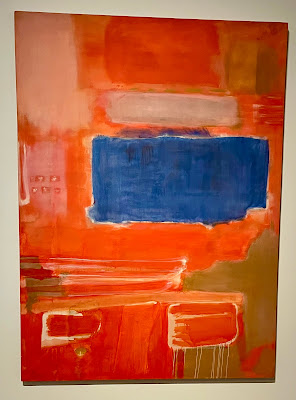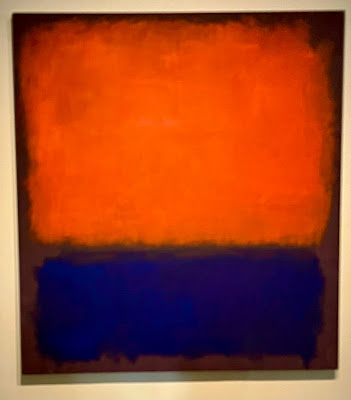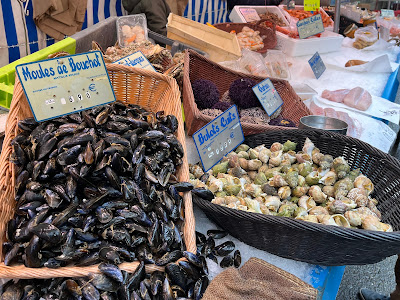To our great delight, the Fondation Louis Vuitton Museum, known popularly as the Frank Gehry building, is once again presenting another blockbuster exhibition: this time, a retrospective of paintings by Mark Rothko. The first such retrospective of his works in France for over 20 years. The painter's name immediately conjures images of large canvases displaying large swathes of intense colors. But as with all artists, there is always a "before", and this exhibition traces his artistic journey from his earlier paintings to his final works. (Photo above by Paul Martin Smith)
Born Markus Yakovlevich Rothkowitz in 1903 in the small village of Dvinsk, Latvia, Rothko's family emigrated to the United States, first the father and older brothers, followed, in 1913, by Rothko and his mother and older sister. They traveled from their arrival point of Ellis Island to Portland, Oregon, where his father and brothers had settled. Rothko left Oregon for Yale University in 1922, followed by a move to New York City. Here he connected with the Art Students League of New York, and later, the Parsons School of Design, where one of his instructors was Arshile Gorky. By the end of the 1920s, he was exhibiting his works in galleries and teaching drawing, painting and clay sculpture to school children. He was also a social activist, a big supporter of the IWW, and attended lectures given by radical socialist Bill Haywood, and Emma Goldman. He became an American citizen in 1938, and changed his name to Mark Rothko around 1940, amid fears of growing antisemitism.
By the mid-1930s, Rothko had an established reputation, alongside fellow artists and friends, Adolph Gottlieb, Barnett Newman and others. The first room of the exhibition displays works from this period of his life.
Stepping into this round gallery, we came face to face with an oil painting from 1936-1937 "Contemplation", and found ourselves already dropping into the essential Rothko viewing pattern: creating one's own inner dialog with the work. Simply looking. In this case, an old man gazing out of a window, with a globe on the sill behind him, maybe dreaming of journeys he has made, or still hopes to make. The black rectangle in the back and the broad, narrow pink one at the bottom, a hint of a form to come?
1937 also saw a series of paintings known as the Subway Paintings. You never actually see the trains. Rather Rothko focuses on horizontal and vertical shapes, showing the staircases...
...the platforms, where passengers, frozen and solitary, are mostly depicted right up against the pillars, elongated like the posts themselves...
...culminating in this painting called "Underground Fantasy" from 1940, where there's a glimpse of a couple embracing behind one pillar and a man cradling...perhaps a newspaper?
At the exit from this gallery, hangs the only self-portrait of Rothko's career, from 1936, when he was still known as Marcus Rothkovitch. A great admirer of Rembrandt's self-portrait (1659), he copied its composition here. His eyes are almost hidden behind his tinted glasses, but again, if you look deeply, they are there, eyeing you intensely!
In fact, Rothko struggled to capture the human figure. He wrote: "For painters of my generation, what mattered above all else was the human figure. But as I tried to reproduce it, I realized that I couldn't do so without mutilating it." As we found in the next gallery, he soon moved away from this form.
With the onset of WWII, Rothko and his friends imagined creating a modern myth as a response to the harshness of a world at war. Using references to Babylonian, Assyrian and Egyptian myths, they searched for a universal language. In this painting, "The Omen of the Eagle" , the theme is from Agamemmnon, composed by a favorite writer of Rothko, the Greek poet Aeschylus. In the original myth, the Greeks perform the flight of two eagles to herald their victory over the Trojans. Painted in 1942, Rothko uses this tale to illustrate chaos and violence, the heads at the top recalling the chorus in the play, the contorted feet at the bottom portraying those killed in ancient and modern wars.
"Slow Swirl at the Edge of the Sea," from 1944, shows softer more graceful images. Rothko had just met his second wife. Perhaps they are the two figures here, floating in the middle of an aquatic world of seaweed and invertebrates. In its neo-surrealist way, it was very soothing to sit and contemplate!By 1946, Rothko moved away from his neo-surrealist style and began to develop abstract forms, which he later termed "multiform". In this 1948 painting there are no figurative forms, instead a tangle of colored shapes move across the canvas, looking like flowing liquid.In the same year, this "Untitled Multiform" is showing some clearly defined rectangular shapes that almost seem to be hanging above the surface of the painting.
By the 1950's Rothko's works were being described as "a Classic Rothko", soon shortened to merely "a Rothko". Two or three rectangles on a colored field became instantly identifiable as "a Rothko". This particular painting especially caught my attention."Green on Blue (Earth Green and White)", painted in 1954. My photo doesn't do it justice, cannot capture the rich, dark green upper rectangle, the deep French navy band in the middle, and the almost diaphonous lower rectangle. It's so much more than white. The more I looked at it, the more pastel pinks, greens, yellows I saw along with the creamy white. Rothko wrote about this: "The experience of depth is an experience of penetration into layers of things more and more distant." There were so many stunning paintings in the exhibition, but my mind kept coming back to this one. It hangs at the University of Arizona Museum of Art in Tucson, a good reason to visit Arizona!This one, also from 1954, with its blurred outlines, invites the viewer to step inside and explore its depths. By the 1960s, Rothko was at the pinnacle of his career. He continued to experiment with his materials. This painting, called simply "No. 14", is one of the largest he ever painted. The richness and brilliance of the orange/red rectangle in the top two-thirds followed by the midnight blue in the bottom third, both against the background of dark brown, stopped every visitor in their tracks! Thankfully for those of us who live in the Bay Area, it is owned by SFMOMA, and will return there at the close of the exhibition.In 1969, Mark Rothko received a commission from UNESCO, along with the Swiss sculptor Alberto Giacometti, to create a room at their headquarters that was being built in Paris. The commission was never realized, but Rothko created a whole body of work in blacks and greys, and the exhibition curators here in Paris chose to include three Giacometti figures in this gallery of black and grey paintings. "Grande Femme II", a tall, spindly figure, made in 1960, reminded me of the tall, spindly figures Rothko painted in his Subway Series back in the late 1930s!
The final room showed a model of what became The Rothko Chapel, a non-demoninational chapel in Houston, Texas, founded by John and Dominique de Menil that opened in 1971. The interior displays fourteen black but color hued paintings by Mark Rothko. The de Menils, who owned several Rothko paintings, wanted to create a space that would engage the human spirit, "to inspire people to action through art and contemplation, to nurture reverence for the highest aspirations of humanity, and to provide a forum for global concerns." They thought Rothko would be an ideal exponent of this idea. For Rothko, it took him on an important spiritual journey. As his son, Chrisopher Rothko, said "For him this was a dream to have a space that he could create himself, not just the paintings, but something that was really dedicated to the human spirit."
After a few hours absorbing this beautiful exhibition, we were ready for a late lunch in the museum cafe, whose ceiling is adorned with Frank Gehry's hanging metal mackerel fish -- according to legend, the favorite fish of his grandmother, who kept them in her bathtub for her weekly Shabbat!
And speaking of fish, our local open-air market displays an amazing selection of fish, some of them at astronomical prices (check out the Sole!)...
...along with endless choices of shellfish: mussels, coquilles-St. Jacques, sea urchins, crabs, cooked whelks, and more!
This very charming flower salesman, sweet-talked me into buying a big bunch of Australian Wattle blossoms, that graced our flat for all of two days!
One final update on the white woolen winter coat. I can now attest that because we have seen more and more on the streets, and also seen them for sale at both Monoprix and Uniqlo, it is clearly the real fashion statement!
 |
| À bientôt! |





















A wonderful tour of the Rothko show. Lucky you to see it in that amazing museum. Thanks so much for sharing.
ReplyDeleteDid you buy a white coat? Thanks for the Rothko tour. Saw them a the Guggenheim!
ReplyDeleteDear Anonymous, I have not bought a white coat! Too impractical à mon avis!
DeleteThis is so generous of you to write and share
ReplyDeletethis experience! Thank you very much and keep
doing it! Christina
What amazing pictures and a history lesson, this is why I love the blog Fiona x
ReplyDeleteThank you, dear Fiona ❤️
Delete